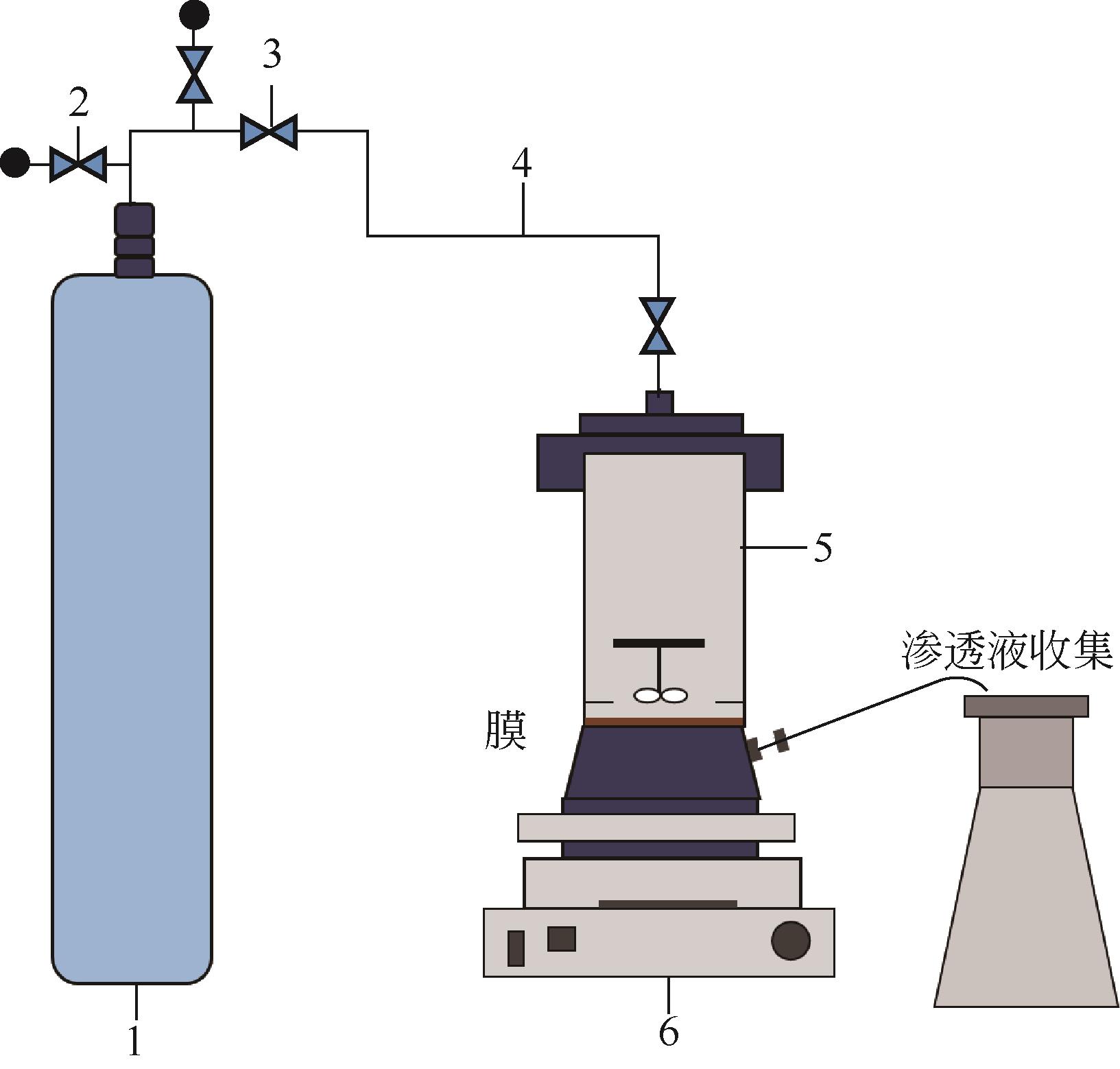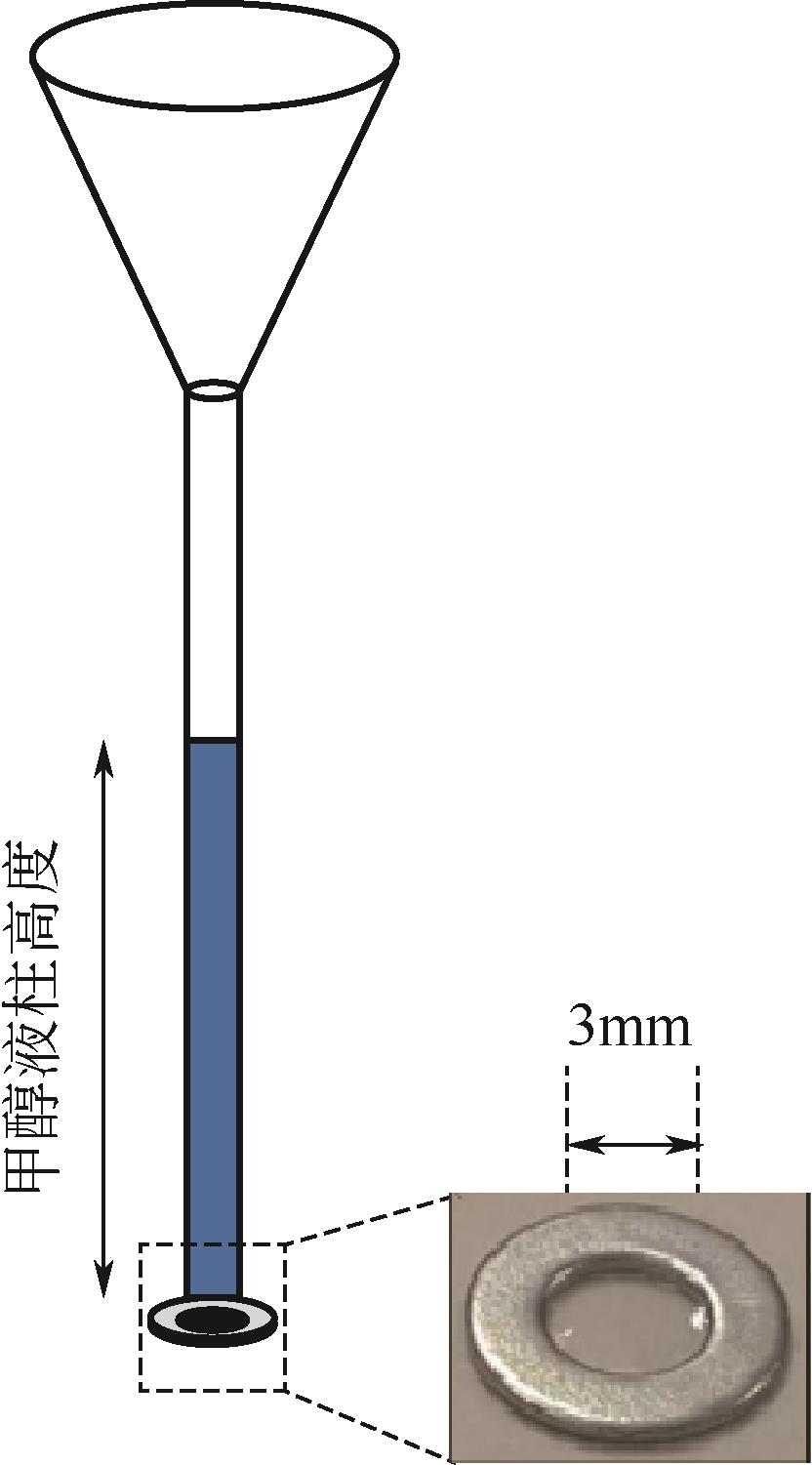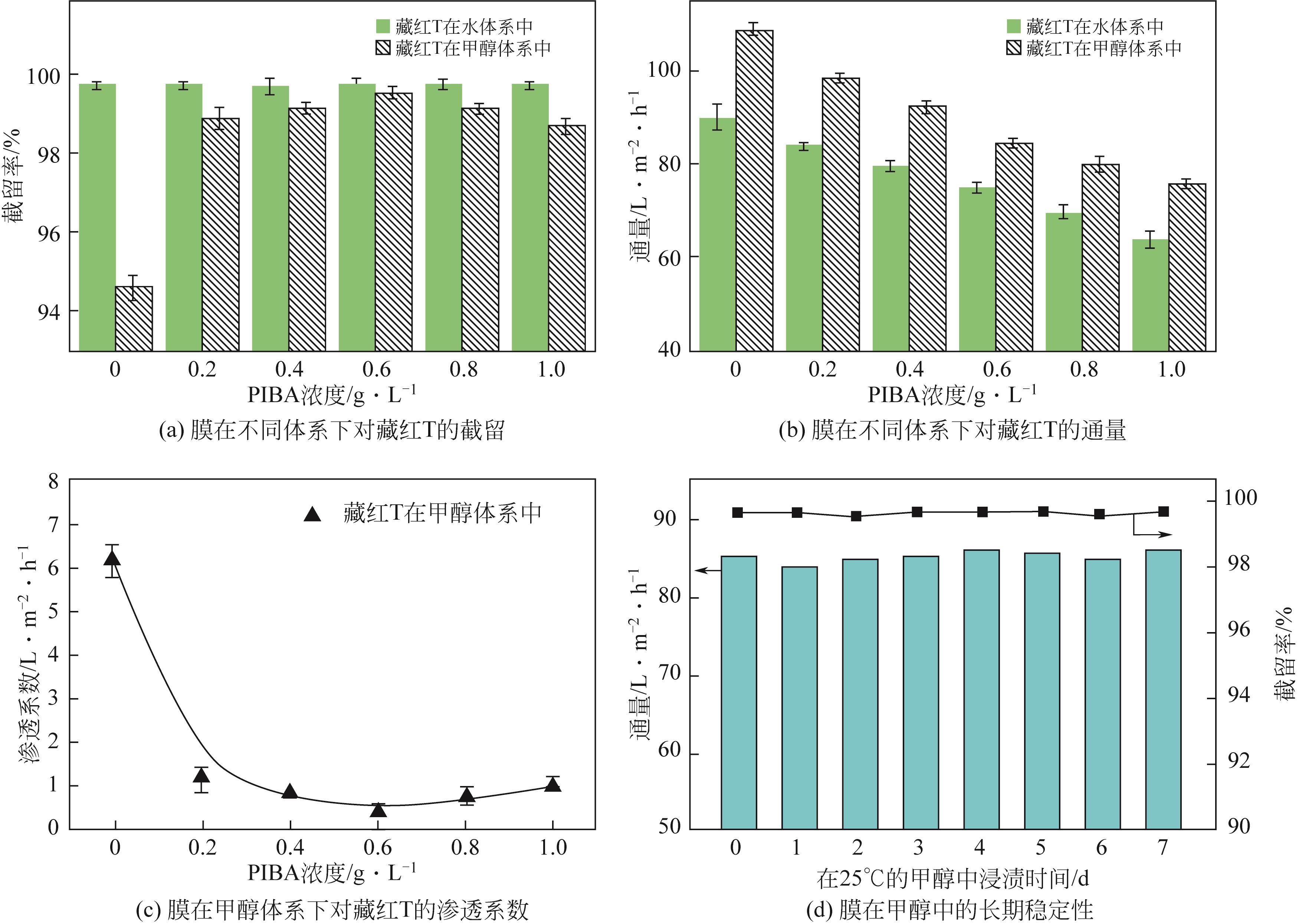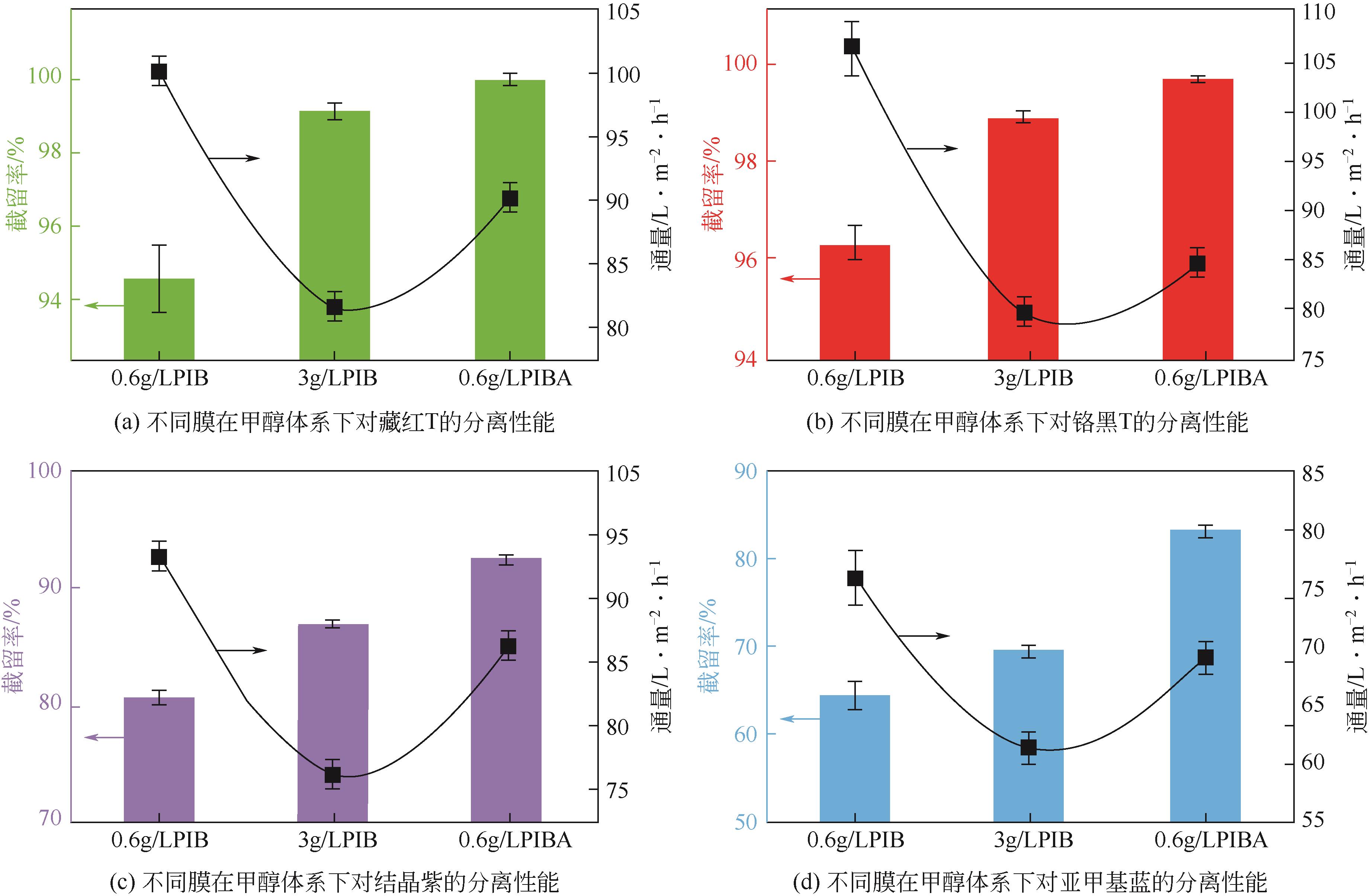化工进展 ›› 2022, Vol. 41 ›› Issue (10): 5530-5540.DOI: 10.16085/j.issn.1000-6613.2021-2667
基于聚异丁烯胺改性的耐甲醇溶胀新型薄膜复合膜
丁俊毅1( ), 陈营东1, 王书浩1, 严文韬1, 周勇1,2(
), 陈营东1, 王书浩1, 严文韬1, 周勇1,2( ), 高从堦1
), 高从堦1
- 1.浙江工业大学化工学院膜分离与水科学技术中心,浙江 杭州 310014
2.浙江工业大学膜分离与水处理协同 创新中心湖州研究院,浙江 湖州 313000
-
收稿日期:2021-12-31修回日期:2022-02-07出版日期:2022-10-20发布日期:2022-10-21 -
通讯作者:周勇 -
作者简介:丁俊毅(1997—),男,硕士研究生,研究方向为膜科学与技术。E-mail:1149857769@qq.com。 -
基金资助:浙江省重点研发计划(2021C01173);国家自然科学基金(22008216)
Methanol swelling-resistant novel TFC membrane based on polyisobutylene amine modification
DING Junyi1( ), CHEN Yingdong1, WANG Shuhao1, YAN Wentao1, ZHOU Yong1,2(
), CHEN Yingdong1, WANG Shuhao1, YAN Wentao1, ZHOU Yong1,2( ), GAO Congjie1
), GAO Congjie1
- 1.Center for Membrane Separation and Water Science & Technology, College of Chemical Engineering, Zhejiang University of Technology, Hangzhou 310014, Zhejiang, China
2.Colaborative Imovation Center for Membrane Separation and Water Treatmert of Zhejiang Province Huzhou Institute, Huzhou 313000, Zhejiang, China
-
Received:2021-12-31Revised:2022-02-07Online:2022-10-20Published:2022-10-21 -
Contact:ZHOU Yong
摘要:
聚合物膜可以在甲醇/染料废液处理中发挥重要作用。为了保证膜在甲醇处理过程中的高性能,提高膜的耐甲醇溶胀性是必要的。然而,关于耐甲醇溶胀膜的研究相对较少。在此,提出将活性聚合物(聚异丁烯胺,PIBA)引入分离层,制备新型耐甲醇溶胀聚酰胺(PA)薄膜复合(TFC)膜。PIBA的掺入增加了膜的表面粗糙度、活性层厚度和活性层背面的致密性。PIBA提高了膜的耐甲醇溶胀性能:当PIBA的添加量从0增加到1g/L时,溶胀率从46.81%下降到15.00%。因此,PA/PIBA膜表现出比PA膜更高的染料(藏红T)截留率(99.53%与94.62%)。此外,在20bar(1bar=0.1MPa)的操作压力下,PA/PIBA膜保持了高通量[84.62L/(m2·h)]和良好的长期运行稳定性。最后,由于聚异丁烯(PIB)在先前的工作中同样用于提高膜的耐甲醇溶胀性,本工作将PIBA与PIB进行了比较,得出PIBA优于PIB。这项工作为开发一种用于甲醇流出物处理的分离膜提供了新途径。
中图分类号:
引用本文
丁俊毅, 陈营东, 王书浩, 严文韬, 周勇, 高从堦. 基于聚异丁烯胺改性的耐甲醇溶胀新型薄膜复合膜[J]. 化工进展, 2022, 41(10): 5530-5540.
DING Junyi, CHEN Yingdong, WANG Shuhao, YAN Wentao, ZHOU Yong, GAO Congjie. Methanol swelling-resistant novel TFC membrane based on polyisobutylene amine modification[J]. Chemical Industry and Engineering Progress, 2022, 41(10): 5530-5540.
| 膜样品 | 水相溶液 | 有机相溶液 | |||
|---|---|---|---|---|---|
MPD浓度 /g·L-1 | CSA浓度 /g·L-1 | pH(TEA) | TMC浓度 /g·L-1 | PIBA浓度 /g·L-1 | |
| P0 | 20 | 40 | 10 | 1 | 0 |
| P1 | 20 | 40 | 10 | 1 | 0.2 |
| P2 | 20 | 40 | 10 | 1 | 0.4 |
| P3 | 20 | 40 | 10 | 1 | 0.6 |
| P4 | 20 | 40 | 10 | 1 | 0.8 |
| P5 | 20 | 40 | 10 | 1 | 1 |
表1 不同活性PA层样品的制备参数
| 膜样品 | 水相溶液 | 有机相溶液 | |||
|---|---|---|---|---|---|
MPD浓度 /g·L-1 | CSA浓度 /g·L-1 | pH(TEA) | TMC浓度 /g·L-1 | PIBA浓度 /g·L-1 | |
| P0 | 20 | 40 | 10 | 1 | 0 |
| P1 | 20 | 40 | 10 | 1 | 0.2 |
| P2 | 20 | 40 | 10 | 1 | 0.4 |
| P3 | 20 | 40 | 10 | 1 | 0.6 |
| P4 | 20 | 40 | 10 | 1 | 0.8 |
| P5 | 20 | 40 | 10 | 1 | 1 |
| 膜 | 表面平均孔径/nm | 表面孔隙密度/个·μm-2 | 表面孔隙率/% |
|---|---|---|---|
| P0 | 19.9±8.5 | 153±23 | 5.40±0.14 |
| P3 | 18.2±7.6 | 109±11 | 2.77±0.25 |
表2 P0膜和P3膜背面孔结构参数
| 膜 | 表面平均孔径/nm | 表面孔隙密度/个·μm-2 | 表面孔隙率/% |
|---|---|---|---|
| P0 | 19.9±8.5 | 153±23 | 5.40±0.14 |
| P3 | 18.2±7.6 | 109±11 | 2.77±0.25 |
| 名称 | 价格/USD·g-1 | 结构式 |
|---|---|---|
| PIB | 1.876 |  |
| PIBA | 0.1705 |  |
表3 PIB与PIBA的结构式与价格对比
| 名称 | 价格/USD·g-1 | 结构式 |
|---|---|---|
| PIB | 1.876 |  |
| PIBA | 0.1705 |  |
| 1 | HYNES N R J, KUMAR J S, KAMYAB H, et al. Modern enabling techniques and adsorbents based dye removal with sustainability concerns in textile industrial sector—A comprehensive review[J]. Journal of Cleaner Production, 2020, 272: 122636. |
| 2 | JIA Fu, YIN Shiyuan, CHEN Lujie, et al. The circular economy in the textile and apparel industry: a systematic literature review[J]. Journal of Cleaner Production, 2020, 259: 120728. |
| 3 | STONE C, WINDSOR F M, MUNDAY M, et al. Natural or synthetic-how global trends in textile usage threaten freshwater environments[J]. Science of the Total Environment, 2020, 718: 134689. |
| 4 | SIVARAM N M, GOPAL P M, BARIK D. Toxic waste from textile industries[M]//Energy from toxic organic waste for heat and power generation. Amsterdam: Elsevier, 2019: 43-54. |
| 5 | KISHOR R, PURCHASE D, SARATALE G D, et al. Environment friendly degradation and detoxification of Congo red dye and textile industry wastewater by a newly isolated Bacillus cohnni (RKS9)[J]. Environmental Technology & Innovation, 2021, 22: 101425. |
| 6 | YUAN Yiqian, NING Xunan, ZHANG Yaping, et al. Chlorobenzene levels, component distribution, and ambient severity in wastewater from five textile dyeing wastewater treatment plants[J]. Ecotoxicology and Environmental Safety, 2020, 193: 110257. |
| 7 | ABOU TALEB M F, ABOU EL FADL F I, ALBALWI H. Adsorption of toxic dye in wastewater onto magnetic NVP/CS nanocomposite hydrogels synthesized using gamma radiation[J]. Separation and Purification Technology, 2021, 266: 118551. |
| 8 | ZHOU Yanbo, LU Jian, ZHOU Yi, et al. Recent advances for dyes removal using novel adsorbents: a review[J]. Environmental Pollution, 2019, 252: 352-365. |
| 9 | VAHEDI S, TAVAKOLI O, KHOOBI M, et al. Application of novel magnetic β-cyclodextrin-anhydride polymer nano-adsorbent in cationic dye removal from aqueous solution[J]. Journal of the Taiwan Institute of Chemical Engineers, 2017, 80: 452-463. |
| 10 | PHUGARE S, PATIL P, GOVINDWAR S, et al. Exploitation of yeast biomass generated as a waste product of distillery industry for remediation of textile industry effluent[J]. International Biodeterioration & Biodegradation, 2010, 64(8): 716-726. |
| 11 | ROBINSON T, CHANDRAN B, NIGAM P. Studies on desorption of individual textile dyes and a synthetic dye effluent from dye-adsorbed agricultural residues using solvents[J]. Bioresource Technology, 2002, 84(3): 299-301. |
| 12 | KATHERESAN V, KANSEDO J, LAU S Y. Efficiency of various recent wastewater dye removal methods: a review[J]. Journal of Environmental Chemical Engineering, 2018, 6(4): 4676-4697. |
| 13 | TAN K B, VAKILI M, HORRI B A, et al. Adsorption of dyes by nanomaterials: recent developments and adsorption mechanisms[J]. Separation and Purification Technology, 2015, 150: 229-242. |
| 14 | WANG Jiade, YAO Jiachao, WANG Lou, et al. Multivariate optimization of the pulse electrochemical oxidation for treating recalcitrant dye wastewater[J]. Separation and Purification Technology, 2020, 230: 115851. |
| 15 | LIU C J, DONG G Y, TSURU T, et al. Organic solvent reverse osmosis membranes for organic liquid mixture separation: a review[J]. Journal of Membrane Science, 2021, 620: 118882. |
| 16 | WANG Chen, PARK M J, SEO D H, et al. Recent advances in nanomaterial-incorporated nanocomposite membranes for organic solvent nanofiltration[J]. Separation and Purification Technology, 2021, 268: 118657. |
| 17 | MINHAS M A, RAUF A, RAUF S, et al. Selective and efficient extraction of cationic dyes from industrial effluents through polymer inclusion membrane[J]. Separation and Purification Technology, 2021, 272: 118883. |
| 18 | SZEKELY G, JIMENEZ-SOLOMON M F, MARCHETTI P, et al.Sustainability assessment of organic solvent nanofiltration: from fabrication to application[J]. Green Chem, 2014, 16(10): 4440-4473. |
| 19 | LI Xiang, CHEN Binglun, CAI Weibin, et al. Highly stable PDMS-PTFPMS/PVDF OSN membranes for hexane recovery during vegetable oil production[J]. RSC Advances, 2017, 7(19): 11381-11388. |
| 20 | PRISKE M, LAZAR M, SCHNITZER C, et al. Recent applications of organic solvent nanofiltration[J]. Chemie Ingenieur Technik, 2016, 88(1/2): 39-49. |
| 21 | HERMANS S, MARIËN H, VAN GOETHEM C, et al. Recent developments in thin film (nano)composite membranes for solvent resistant nanofiltration[J]. Current Opinion in Chemical Engineering, 2015, 8: 45-54. |
| 22 | JIMENEZ SOLOMON M F, BHOLE Y, LIVINGSTON A G. High flux hydrophobic membranes for organic solvent nanofiltration (OSN)——interfacial polymerization, surface modification and solvent activation[J]. Journal of Membrane Science, 2013, 434: 193-203. |
| 23 | XIA L L, MCCUTCHEON J R. Understanding the influence of solvents on the intrinsic properties and performance of polyamide thin film composite membranes[J]. Separation and Purification Technology, 2020, 238: 116398. |
| 24 | XU Sunjie, SHEN Qian, XU Zhenliang, et al. Novel designed TFC membrane based on host-guest interaction for organic solvent nanofiltration (OSN)[J]. Journal of Membrane Science, 2019, 588: 117227. |
| 25 | JIMENEZ SOLOMON M F, BHOLE Y, LIVINGSTON A G. High flux membranes for organic solvent nanofiltration (OSN) —Interfacial polymerization with solvent activation[J]. Journal of Membrane Science, 2012, 423/424: 371-382. |
| 26 | LIU Chang, YANG Jing, GUO Bianbian, et al. Interfacial polymerization at the alkane/ionic liquid interface[J]. Angewandte Chemie International Edition, 2021, 60(26): 14636-14643. |
| 27 | SARANGO L, PASETA L, NAVARRO M, et al. Controlled deposition of MOFs by dip-coating in thin film nanocomposite membranes for organic solvent nanofiltration[J]. Journal of Industrial and Engineering Chemistry, 2018, 59: 8-16. |
| 28 | NAVARRO M, BENITO J, PASETA L, et al. Thin-film nanocomposite membrane with the minimum amount of MOF by the Langmuir-Schaefer technique for nanofiltration[J]. ACS Applied Materials & Interfaces, 2018, 10(1): 1278-1287. |
| 29 | DUONG P H H, ANJUM D H, PEINEMANN K V, et al. Thin porphyrin composite membranes with enhanced organic solvent transport[J]. Journal of Membrane Science, 2018, 563: 684-693. |
| 30 | Yuyan HAI, ZHANG Jinli, SHI Chang, et al. Thin film composite nanofiltration membrane prepared by the interfacial polymerization of 1,2,4,5-benzene tetracarbonyl chloride on the mixed amines cross-linked poly(ether imide) support[J]. Journal of Membrane Science, 2016, 520: 19-28. |
| 31 | XU Sunjie, SHEN Qian, TONG Yihao, et al. GWF-NH2 enhanced OSN membrane with trifluoromethyl groups in polyamide layer for rapid methanol recycling[J]. Separation and Purification Technology, 2020, 240: 116619. |
| 32 | CHAN E P, YOUNG A P, LEE J H, et al. Swelling of ultrathin crosslinked polyamide water desalination membranes[J]. Journal of Polymer Science Part B: Polymer Physics, 2013, 51(6): 385-391. |
| 33 | HERMANS S, DOM E, MARIËN H, et al. Efficient synthesis of interfacially polymerized membranes for solvent resistant nanofiltration[J]. Journal of Membrane Science, 2015, 476: 356-363. |
| 34 | ZHAO Yanyan, YUAN Qipeng. Effect of membrane pretreatment on performance of solvent resistant nanofiltration membranes in methanol solutions[J]. Journal of Membrane Science, 2006, 280(1/2): 195-201. |
| 35 | WANG Shuhao, GU Kaifeng, WANG Jian, et al. Enhanced the swelling resistance of polyamide membranes with reinforced concrete structure[J]. Journal of Membrane Science, 2019, 575: 191-199. |
| 36 | HABIB S, WEINMAN S T. A review on the synthesis of fully aromatic polyamide reverse osmosis membranes[J]. Desalination, 2021, 502: 114939. |
| 37 | LIND M L, GHOSH A K, JAWOR A, et al. Influence of zeolite crystal size on zeolite-polyamide thin film nanocomposite membranes[J]. Langmuir, 2009, 25(17): 10139-10145. |
| 38 | FREGE V. Swelling and morphology of the skin layer of polyamide composite membranes: an atomic force microscopy study[J]. Environmental Science & Technology, 2004, 38(11): 3168-3175. |
| 39 | KARAN S, JIANG Z, LIVINGSTON A G, et al. Sub-10nm polyamide nanofilms with ultrafast solvent transport for molecular separation[J]. Science, 2015, 348(6241): 1347-1351. |
| 40 | GEENS J, DER BRUGGEN B V, VANDECASTEELE C. Characterisation of the solvent stability of polymeric nanofiltration membranes by measurement of contact angles and swelling[J]. Chemical Engineering Science, 2004, 59(5): 1161-1164. |
| 41 | VAN GOETHEM C, VERBEKE R, HERMANS S, et al. Controlled positioning of MOFs in interfacially polymerized thin-film nanocomposites[J]. Journal of Materials Chemistry A, 2016, 4(42): 16368-16376. |
| 42 | WANG Shuhao, ZHOU Yong, GAO Congjie. Novel high boron removal polyamide reverse osmosis membranes[J]. Journal of Membrane Science, 2018, 554: 244-252. |
| 43 | GHOSH A K, JEONG B H, HUANG Xiaofei, et al. Impacts of reaction and curing conditions on polyamide composite reverse osmosis membrane properties[J]. Journal of Membrane Science, 2008, 311(1/2): 34-45. |
| 44 | SHEN Hongmei, WANG Shuhao, LI Yunhao, et al. MeSiCl3 functionalized polyamide thin film nanocomposite for low pressure RO membrane desalination[J]. Desalination, 2019, 463: 13-22. |
| 45 | SHI Mengqi, WANG Zhi, ZHAO Song, et al. A novel pathway for high performance RO membrane: preparing active layer with decreased thickness and enhanced compactness by incorporating tannic acid into the support[J]. Journal of Membrane Science, 2018, 555: 157-168. |
| 46 | YAN Hao, MIAO Xiaopei, XU Jian, et al. The porous structure of the fully-aromatic polyamide film in reverse osmosis membranes[J]. Journal of Membrane Science, 2015, 475: 504-510. |
| 47 | SHEN Hongmei, WANG Shuhao, XU Hao, et al. Preparation of polyamide thin film nanocomposite membranes containing silica nanoparticles via an in situ polymerization of SiCl4 in organic solution[J]. Journal of Membrane Science, 2018, 565: 145-156. |
| 48 | ZHENG Junfeng, LI Meng, YU Kai, et al. Sulfonated multiwall carbon nanotubes assisted thin-film nanocomposite membrane with enhanced water flux and anti-fouling property[J]. Journal of Membrane Science, 2017, 524: 344-353. |
| 49 | GUAN Jingyuan, FAN Lin, LIU Yanan, et al. Incorporating arginine-FeⅢ complex into polyamide membranes for enhanced water permeance and antifouling performance[J]. Journal of Membrane Science, 2020, 602: 117980. |
| 50 | MA D C, PEH S B, HAN G, et al. Thin-film nanocomposite (TFN) membranes incorporated with super-hydrophilic metal-organic framework (MOF) UiO-66: toward enhancement of water flux and salt rejection[J]. ACS Applied Materials & Interfaces, 2017, 9(8): 7523-7534. |
| [1] | 贺美晋. 分子管理在炼油领域分离技术中的应用和发展趋势[J]. 化工进展, 2023, 42(S1): 260-266. |
| [2] | 张祚群, 高扬, 白超杰, 薛立新. 二次界面聚合同步反扩散原位生长ZIF-8纳米粒子制备聚酰胺混合基质反渗透(RO)膜[J]. 化工进展, 2023, 42(S1): 364-373. |
| [3] | 崔守成, 徐洪波, 彭楠. 两种MOFs材料用于O2/He吸附分离的模拟分析[J]. 化工进展, 2023, 42(S1): 382-390. |
| [4] | 李世霖, 胡景泽, 王毅霖, 王庆吉, 邵磊. 电渗析分离提取高值组分的研究进展[J]. 化工进展, 2023, 42(S1): 420-429. |
| [5] | 郭强, 赵文凯, 肖永厚. 增强流体扰动强化变压吸附甲硫醚/氮气分离的数值模拟[J]. 化工进展, 2023, 42(S1): 64-72. |
| [6] | 廖志新, 罗涛, 王红, 孔佳骏, 申海平, 管翠诗, 王翠红, 佘玉成. 溶剂脱沥青技术应用与进展[J]. 化工进展, 2023, 42(9): 4573-4586. |
| [7] | 林晓鹏, 肖友华, 管奕琛, 鲁晓东, 宗文杰, 傅深渊. 离子聚合物-金属复合材料(IPMC)柔性电极的研究进展[J]. 化工进展, 2023, 42(9): 4770-4782. |
| [8] | 朱传强, 茹晋波, 孙亭亭, 谢兴旺, 李长明, 高士秋. 固体高分子脱硝剂选择性非催化还原NO x 特性[J]. 化工进展, 2023, 42(9): 4939-4946. |
| [9] | 李雪佳, 李鹏, 李志霞, 晋墩尚, 郭强, 宋旭锋, 宋芃, 彭跃莲. 亲水和疏水改性膜的抗结垢和润湿能力的对比[J]. 化工进展, 2023, 42(8): 4458-4464. |
| [10] | 徐杰, 夏隆博, 罗平, 邹栋, 仲兆祥. 面向膜蒸馏过程的全疏膜制备及其应用进展[J]. 化工进展, 2023, 42(8): 3943-3955. |
| [11] | 李伯耿, 罗英武, 刘平伟. 聚合物产品工程研究内容与方法的思考[J]. 化工进展, 2023, 42(8): 3905-3909. |
| [12] | 王报英, 王皝莹, 闫军营, 汪耀明, 徐铜文. 聚合物包覆膜在金属分离回收中的研究进展[J]. 化工进展, 2023, 42(8): 3990-4004. |
| [13] | 潘宜昌, 周荣飞, 邢卫红. 高效分离同碳数烃的先进微孔膜:现状与挑战[J]. 化工进展, 2023, 42(8): 3926-3942. |
| [14] | 周龙大, 赵立新, 徐保蕊, 张爽, 刘琳. 电场-旋流耦合强化多相介质分离研究进展[J]. 化工进展, 2023, 42(7): 3443-3456. |
| [15] | 陆诗建, 刘苗苗, 杨菲, 张俊杰, 陈思铭, 刘玲, 康国俊, 李清方. 改良型CO2湿壁塔内气液两相流动规律及传质特性[J]. 化工进展, 2023, 42(7): 3457-3467. |
| 阅读次数 | ||||||
|
全文 |
|
|||||
|
摘要 |
|
|||||








